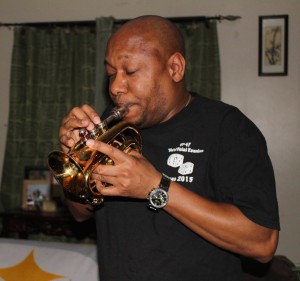It would be an exaggeration to say that I was born for this job. Obviously it’s a fact that everything that came before now in my life—including my birth and my second-grade trip to see Oliver! at the Phoenix Little Theater—led me to where I am today, but that is also true of everyone at every point to which their lives take them.
What I can say with some certainty is that I’ve been rehearsing for the job of editor-in-chief of American Theatre for even longer than I’ve consciously wanted it—that my years of seeing theatre and performance in downtown L.A., at the Music Center and at LATC, and my decade at the helm of Back Stage West, in which I took the “West” as my mandate to cover stages from San Diego to Seattle, as well as Texas and Colorado, seeded in me a healthy sense that theatre is an intensely local American art form, and that New York is just one especially populous region in the nation’s resident theatre scene. Yes, Broadway is American theatre’s commercial capital, but not its beating heart.
Indeed, that organ, as my illustrious predecessor, the magazine’s founding editor, Jim O’Quinn, points out in this must-read nutshell history of the American theatre’s last 50 years, is no longer in any one place but instead sprawls in a circulatory panoply from sea to shining sea. Its lifeblood, even in New York City, pumps from its nonprofit theatres, from giant LORT powerhouses and performing arts centers to tiny storefronts and itinerant ensembles. And its health is emphatically not measured at the box office or on a balance sheet but in the theatre’s irreducibly intimate impact on individual lives and communities.
Imagining a United States minus its nonprofit theatres is a dystopian thought experiment that’s worth a try, if only because it starkly clarifies how much the resident theatre movement has contributed to the U.S. character, culture, and economy. It should also be, if we’re honest, something of a wakeup call to how much more the theatre still could do to contribute to our politics, our discourse, our national imagination, not to mention our material well-being and social progress. If we in the nonprofit theatre world can often feel taken for granted by the larger culture, as if we’ll just always be here plugging away, somehow magically funded by someone, we should admit the extent to which many of us also take our own existence, and hence our significance and social purpose, for granted. It’s safe to say that we are in the midst of a generational soul-searching moment, not the field’s first (in my experience) but just as urgent and occasionally disorienting as ever before, in which we’re asking, as we continually must, not how we’re going to make it, but why? Who are we doing our art for? (Predictably, answers vary.)
For what is true of any individual artist’s work is also true of arts institutions: Both are fundamentally mission-driven, inspired by something larger than the next commission deadline or opening night, let alone the bottom line. Theatre companies no less than individual theatre artists bring into the world beautiful things the world doesn’t know it needs, would never think to ask for, and very often promptly forgets how it came by (hence the whole taking-for-granted thing).

And so the focus of American Theatre has been and will continue be as much on why we do this as what we do and how we do it. It’s the reason our publisher, Theatre Communications Group, gathers the field annually at a conference, as it did recently in Cleveland, to meet and challenge each other not only with our best practices but with our wildest dreams and most burning concerns; it’s why we write not only about the professional training institutions that prepare young artists for the field but about high school theatre programs and teaching artists and censorship in school productions; it’s why we heartily cove such flagrantly noncommercial enterprises as silent artist retreats and site-specific promenade productions and eco-theatrical ventures; and why, when we sit down with a giant of the field like Goodman Theatre executive director Roche Schulfer, we talk about mission and vocation as much as dollars and cents.
Of course, we also always keep our sights trained on the what and the how, and perhaps especially the who, of the American theatre. This week, for instance, we’ll publish another installment in what we’ve affectionately nicknamed our “love column,” a spinoff of one of our most popular features ever, in which Eliza Bent writes about theatre couples who somehow manage to make life and work together; we’ll have a review of a new book about dramaturgs and their oft-misunderstood work; and we’ll post a Q&A with “True Blood” star Rutina Wesley about her turn as Viola in the Old Globe’s new production of Twelfth Night.
That’s all in the midst of the online rollout of our July/August print edition, of which McCarter stalwart Emily Mann is our cover subject and the uncanny second life of puppetry is a strong theme. Expect more, including my in-depth Q&A with Lynn Nottage, whose new play Sweat goes up at Oregon Shakespeare Festival later this month; a dialogue between playwrights Jordan Harrison and Madeleine George about Harrison’s beautiful, wrenching new play Marjorie Prime, published in its entirety in the current issue (our plays, by the way, are just about the only thing in our print editions that won’t be made available online); and a chat with Jennifer Holliday, appearing this month in the Duke Ellington revue Sophisticated Ladies at Austin’s ZACH Theatre.
We’re also gearing up for a September issue, Jim O’Quinn’s last on the masthead as Editor-in-Chief, whose cover subject is only the most exciting musical theatre artist in a generation (betcha $10 you can guess who), and whose pages, both in print and online, will be packed as ever with things you don’t even know you need to know about the field we’re in—the field I’m happy and proud, even possibly somewhat destined, to serve.
Read on, and tell us what you think!



